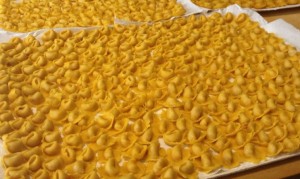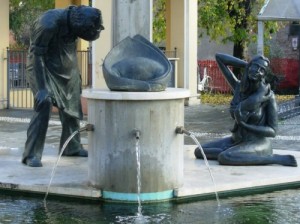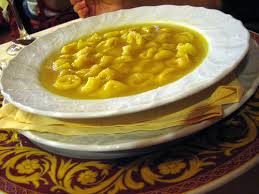Tortellini !!!
History
In the past there were a lot of controversies between Bologna and Modena about the paternity of tortellino. After a number of heated discussions they chose the village of Castelfranco Emilia, which was the place of the imaginary meeting between the innkeeper and the “mythical navel“.
The choice was not fortuitous. In fact Castelfranco is half way between Bologna and Modena. It was in the province of Bologna until 1927 when it was in the Estense dukedom but since 1927 it has been in the province of Modena. That is why the vexed question was born. Now, even if it is in the province of Modena, it is part of the diocese of Bologna. This is the diplomatic solution which succeeded in meeting everybody’s wishes. Anyway everybody must know that the “Via Emilia” (Emilia street) is known as the street of the “twisted” pasta, that is a twisted pasta with a filling inside. In fact tortellino or tortello means “twisted”.

So, leaving Piacenza and going through Parma, we meet the Anolini, in Reggio Emilia there are the Tortelli with vegetables (in the filling there are green vegetables, such as herbs, and ricotta) or Tortelli with squash and amaretto and Cappelletti with meat. Coming down through Modena, Castelfranco and Bologna we can tasteTortellini. Continuing along the via Emilia, we reach Forlì where we find Cappelletti with cheese and if we go to Ferrara we can eat the Cappellacci with squash but without amaretto.
The tortellino, like all the big symbols, boasts of numerous origins. The poet Alfredo Testoni wrote about this matter in a controversial tone: “Bologna is not famous because it is “mother of learning”. L’è pr I turtlei e pr’l so consum ch’la s’è fatt una strada!” [It is only thanks to the tortellini and their success everywhere that Bologna is so well known]
According to one of the theories it was the noblelady Dorotea Lepi who, after reading a XIV century treatise, decided to meet her greedy husband’s needs at least when dinner was served! Another theory is that the inventor was Pietro Filargo who became Pope Alexander V. A number of legends refer to the feminine navel: Ostilio Lucarini, for exemple, in his comedy: “Quell ch’ha inventà i turtlei” [The person who invented tortellini] tells the story of the cook Pirulein who was inspired by his landlady’s navel. Giuseppe Ceri, in his burlesque poem, tells that Venus, Mars and Volcano met one evening at the Dogana’s Inn in Castelfranco Emilia (a village in the suburbs of Bologna) and they spent the night there sleeping together in the same bed. The following morning Volcano and Mars went down to the kitchen to take refreshment with 100 eggs. In the meantime the cook went to the room to serve Venus and he realized she was naked. He gazed at her and went mad! He went back into the kitchen and was very confused but he decided to immortalize that vision. As he was not able to draw he took a piece of dough and “l’oste che era guercio e Bolognese per imitar di Venire il bellico l’arte di fare I tortellini apprise” [The innkeeper, who was cross-eyed and Bolognese, in order to remember the navel of Venus, created the art of making tortellini].
In order to immortalize this last legend the “Learned Brotherhood”, together with the “Saint Nicholas’ Brotherhood” in Castelfranco, unveiled a bronze statue in one of the Squares of the village.

In the year 1500 in the diary of the Senate in Bologna there is written that a “minestra de torteleti” [soup of tortellini] was served to 16 of the tribunes. A few years later, in 1570, a Bolognese cook, possibly Bartolomeo di Scappi, who was Pope Pio V’s cook, published some recipes where tortellini were mentioned.
All the theories are amusing and intriguing but, as a matter of facts, a real inventor of the tortellino doesn’t exist or at least we don’t know for sure. The only certainty was given by Pellegrino Artusi who, at the end of the XIX Century, codified the classic filling which included mortadella. He contributed, with his work, to propagate its fame.
For about 1000 tortellini:
300 gr. pork loin
300 gr. prosciutto
300 gr. genuine mortadella from Bologna
450 gr. parmesan cheese
3 chicken eggs
nutmeg flavour
For the broth:
1 kg. of beef
½ farmyard cappone [hen]
.celery
carrot
onion
salt

The preparation
It must be very thorough: you must put a mixture of salt, pepper, rosmary and garlic on the loin and leave it in a pan for two days, then cook it on a slow frame adding a little butter. Take it out of the fire and clean it from the mixture. Then mince the pork, the prosciutto and mortadella very finely and knead everything with parmesan cheese and the eggs. Add the flavour of the nutmeg. The dough must be mixed for a long time until it is well amalgamated and it must rest for at least 24 hours before filling the tortellini.
Of course the excellence of the filling depends on the quality of the raw materials. In order to taste a good tortellino you must prepare an excellent broth which you can make putting a farmyard capon into the water and adding those parts of the beef that are notoriously suitable for broth, such as the brisket etc.
source: Confraternita del tortellino





Leave a comment